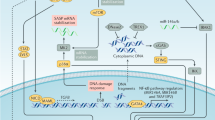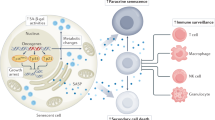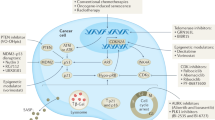Abstract
Oncogene-induced senescence is a cellular response that may be crucial for protection against cancer development1,2, but its investigation has so far been restricted to cultured cells that have been manipulated to overexpress an oncogene. Here we analyse tumours initiated by an endogenous oncogene, ras, and show that senescent cells exist in premalignant tumours but not in malignant ones. Senescence is therefore a defining feature of premalignant tumours that could prove valuable in the diagnosis and prognosis of cancer.
Similar content being viewed by others
Main
We used a mouse model for cancer initiation in humans: the animals have a conditional oncogenic K-rasV12 allele that is activated only by the enzyme Cre recombinase3, causing them to develop multiple lung adenomas (premalignant tumours) and a few lung adenocarcinomas (malignant tumours). Senescence markers previously identified in cultured cells were used to detect oncogene-induced senescence in lung sections from control mice (expressing Cre) and from K-rasV12-expressing mice (expressing Cre and activated K-rasV12). We analysed p16INK4a, an effector of in vitro oncogene-induced senescence1, and de novo markers that we identified by using DNA microarray analysis of in vitro oncogene-induced senescence (see supplementary information). These de novo markers are p15INK4b (also known as CDKN2B), Dec1 (BHLHB2) and DcR2 (TNFRSF10D). In addition, we looked for two features evident in cultured senescent cells, namely the expression of senescence-associated β-galactosidase4 and the presence of senescence-associated heterochromatin foci5.
Staining with antibodies against p16INK4a, p15INK4b, Dec1 and DcR2 revealed abundant positive cells in adenomas, whereas adenocarcinomas were essentially negative (Fig. 1a). By contrast, the proliferation marker Ki-67 revealed a weak proliferative index in adenomas compared with adenocarcinomas (Fig. 1a). Lung cryosections from K-rasV12 mice stained for senescence-associated β-galactosidase gave an intense signal in the adenomas, whereas adenocarcinomas gave a weak or negative signal (Fig. 1b). Adenomas were also strongly positive for HP1-γ, which indicates the formation of senescence-associated heterochromatin foci5, whereas adenocarcinomas were negative (Fig. 1c). These results were consistently found when using K-rasV12 mice carrying Cre transgenic alleles that were expressed either inducibly by tamoxifen (Cre-ER) or constitutively (CMV-Cre)3; 5–10 mice were analysed for each marker. The results have also been confirmed by immunoblotting and by quantitative real-time polymerase chain reaction with reverse transcription (see supplementary information; these analyses also included p19ARF, an effector of senescence-associated β-galactosidase6).
a, Immunohistochemical analysis of the different tissue types for the indicated proteins. b, Senescence-associated β-galactosidase expression. A lung section is shown that contains one adenoma (top, blue stained) and one adenocarcinoma (bottom). Inset, negative control. c, Immunofluorescence using anti-HP1-γ staining of adenoma (top) and adenocarcinoma (bottom). Insets, double staining with anti-HP1-γ (red) and DAPI (4,6-diamino-2-phenylindole, which stains cell nuclei) (blue). Dotted line, boundary between adenoma and normal tissue. (See supplementary information for further details.)
Extending these observations, we combined the K-rasV12 allele with a transgenic Cre allele that targets the expression of the oncogene to the pancreas. These compound mice develop premalignant lesions (pancreatic intraductal neoplasias) that progress into malignant ductal adenocarcinomas (C.G., A.J.S. and M. Barbacid, unpublished results). As in lung adenomas, these premalignant lesions were positive for our oncogene-induced senescence markers, whereas ductal adenocarcinomas were negative. Similarly, chemically induced skin papillomas, which harbour H-ras oncogenic mutations, were also positive for oncogene-induced senescence markers (see supplementary information).
We infer from our findings that oncogene-induced senescence may help to restrict tumour progression. In most cells, oncogenic K-ras signalling is attenuated and is therefore not sufficient to trigger tumour formation or senescence3,7. Presumably, rare cells that do not fully attenuate oncogenic Ras are at the origin of both premalignant and malignant tumours. We conclude that a substantial number of cells in premalignant tumours undergo oncogene-induced senescence, but that cells in malignant tumours are unable to do this owing to the loss of oncogene-induced senescence effectors such as p16INK4a or p53.
References
Serrano, M., Lin, A. W., McCurrach, M. E., Beach, D. & Lowe, S. W. Cell 88, 593–602 (1997).
Lowe, S. W., Cepero, E. & Evan, G. Nature 432, 307–315 (2004).
Guerra, C. et al. Cancer Cell 4, 111–120 (2003).
Dimri, G. P. et al. Proc. Natl Acad. Sci. USA 92, 9363–9367 (1995).
Narita, M. et al. Cell 113, 703–716 (2003).
Palmero, I., Pantoja, C. & Serrano, M. Nature 395, 125–126 (1998).
Tuveson, D. A. et al. Cancer Cell 5, 375–387 (2004).
Author information
Authors and Affiliations
Corresponding author
Ethics declarations
Competing interests
The authors declare no competing financial interests.
Supplementary information
Rights and permissions
About this article
Cite this article
Collado, M., Gil, J., Efeyan, A. et al. Senescence in premalignant tumours. Nature 436, 642 (2005). https://doi.org/10.1038/436642a
Issue Date:
DOI: https://doi.org/10.1038/436642a
This article is cited by
-
Cellular senescence gene TACC3 associated with colorectal cancer risk via genetic and DNA methylated alteration
Archives of Toxicology (2024)
-
Aging microenvironment and antitumor immunity for geriatric oncology: the landscape and future implications
Journal of Hematology & Oncology (2023)
-
The journey from melanocytes to melanoma
Nature Reviews Cancer (2023)
-
Senescence program and its reprogramming in pancreatic premalignancy
Cell Death & Disease (2023)
-
Nectin-4 regulates cellular senescence-associated enlargement of cell size
Scientific Reports (2023)
Comments
By submitting a comment you agree to abide by our Terms and Community Guidelines. If you find something abusive or that does not comply with our terms or guidelines please flag it as inappropriate.




